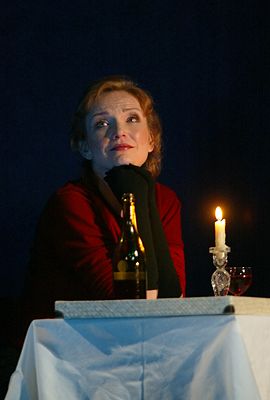|

Particular virtues
Richard Strauss's 'Ariadne auf Naxos' at Covent Garden,
reviewed by ROBERT HUGILL
It was unfortunate for Anne Schwanewilms that her first appearance as Ariadne in Richard Strauss's opera at Covent Garden was, for most people, notable that she was not Deborah Voight. We had first seen Schwanewilms in Euryanthe at Glyndebourne and were looking forward to her performance for her own particular virtues.
Seeing Christoph Loy's production for the second time, we have become inured to its oddities, no longer sitting through the opening of the second half wondering why the cast are performing a different opera to the one they prepared in the prologue; and I don't sit waiting at the end for a stage transformation which will parallel the transformation in the music.

Anne Schwanewilms in the title role of Strauss's 'Ariadne auf Naxos' at Covent Garden, London UK. Photo © 2004 Clive Barda
|
Commonly, people divide Strauss's work into two parts; the back-stage prologue and the opera itself. But surely the work divides into three; the final duet transports the protagonists (and us) into a world which completely transcends all previous limitations. Usually stage directors mirror this; just think of the magical, Klimt-like transformation in the Royal Opera's previous production, or Graham Vick's opening up of the Coliseum stage for the ENO. Christoph Loy on the other hand, seems to have been thinking rather too hard about the opera. So what we get is a stunning (but unnecessary) scene change towards the beginning of the whole work; thus rather standing the work's proportions on their head by giving us an opening transformation rather than a closing one. The fact that this scenic device (the whole set shifts vertically to show us the ground floor and basement) is unnecessary is surely part of Loy's point. No stunning physical transformation happens at the end, Ariadne's room remains her room (albeit decorated in a new colour), and at the end Ariadne and Bacchus go off into her bedroom. Loy is telling us that the transformation is all in Ariadne's head and that Zerbinetta is right all along in her comment that Ariadne's mourning for Theseus will not last for ever, she is just waiting for a new prince.
Continue >>
Copyright © 17 July 2004
Robert Hugill, London UK

|

